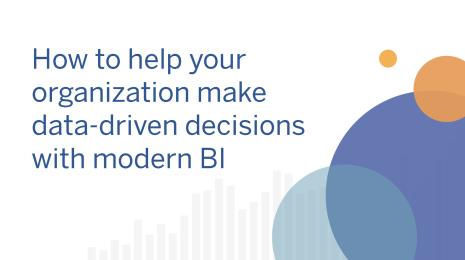How do I use Tableau to transform my organization?
Or perhaps, the better question is: How do I make a change?
Since giving my talk at the Tableau Conference, I’ve had a few people ask: How do I get this to spread throughout my organization? My answers have varied, but in a lot of ways, they’ve missed the mark. So, in apologia, here’s perhaps the best answer I can give.
As humans, we’re social creatures. We depend on each other to round one another out. There’s things we can’t do (fix plumbing, navigate out of a paper sack, boil water properly, match socks) that others can…some can even do ALL of these things rather easily. But, those are also the same people who give me data with labels like this: left back basement, master bedroom, kitchen. And I spend more time than one should figuring out where the sensors were and how to normalize the data (more on this later).
Tableau is an outlier in the world of BI. Unlike so many tools, it really focuses on making the analytical journey a joy. It’s easy to get lost in the analysis and realize all the findings you have. Then comes the hard part…making something usable for others. This isn’t hard from a technology standpoint. It’s building something with grammar with a flow that serves versus hindering the person who will use it.
I discussed in my talk that it’s not just throwing charts on a dashboard. And people (who need applauded) sat there through 25+ demonstrations of rejiggering the same dashboard in a number of ways. The point was this: It’s not just formatting; it’s building something cohesive. I call it grammar, but I’m sure we could name it 500 other things, too.
But once you learn this (or anything else in Tableau), how do you get others to do it? How do you increase adoption or spread this like wildfire?
Chip and Dan Heath have given me several blueprints for my career, one being the book Switch. It talks about how to make a change. And, if you’ve somehow made it this far without reading it, you should run out and buy it. Like right now. It’s worth every penny. I’ve lost track of how many copies I’ve bought (see above about skills).
Here’s the quick answer:

There are three big things you can use to make a change.
- You have the rider, who responds to logic, like turn signals and signs. Reason works at this level. All logical arguments get presented to the rider.
- You have the elephant, a very emotional creature which can be hard to control by just pulling on the reins. You can make the elephant mad and get it running. But elephants are also social. They even bury their dead and remember.
- You have the path, which gives us easy walking space to get places. You can make this hostile or nice.
The Heath brothers frame this best:
- Direct the rider
- Motivate the elephant
- Shape the path
How do you use this to better Tableau use across your organization?

Most of us are quite good with what gets the rider going. This is Tableau Server reports on who’s using Tableau, how well, and so forth. We like numbers, and, man, can we fish them out. This is case studies. Hey, look, ma, we saved 20% on widgets because we found something. You can, too.
Here are the two areas we miss.
Motivate the elephant
Our logical appeals are quite good. Our call to emotion—you know, fear—is usually what suffers. We’re analysts for crying out loud! Spock is our hero! (Okay, maybe that’s just me.)
Analytics alone can be scary. What are we measuring? Why are measuring it? What are we going to do with this information? Who is going to get canned from this (it’s a real question and one I get asked quite a lot)? Fear is a powerful tranquilizer, despite what we’ve learned about it as a motivator. If you want change, scaring the elephant gets you trampled. So the key here is to find and channel the right emotions.

I worked at a place where the answer was to get the boss hopping mad. If the boss was mad, things happened. So I figured out a way to make the boss mad at the problem, not me. When people get mad about problems, they change things pretty quickly. This can be massive inefficiencies, but also disparities in service, gap in care, or what have you. You’re doing this for a reason. Find the emotion that unifies everyone.
Other times, the change just seems overwhelming. The elephant is massive, and so the motivation has to merit the movement. This is going to the gym in negative-degree temps with a snowstorm. It takes a lot of motivation. Or cooking—holy cow, does that take some motivation. So, one way to make this easier is to shrink what’s required: Park in the garage so no scraping or pre-cook all the onions (those myths about onions browning in 10 minutes—yeah…). Or start some reports, but…are you ready…leave them unfinished so people can pick them up. How can you pre-cook the onions?
The other way? A simple mind trick. The elephant is big, but sometimes the elephant needs to feel bigger. So, fib. Or, as some people call it, “reframe the narrative.” This one works well in my house. Just tell yourself you’re the kind of person that __ (keeps the kitchen clean, recycles, goes to the gym, etc). Or make it the norm to do these things. Not doing X is like not brushing your teeth. Pick that identifier. You’re the type of analyst that (works quickly, delivers on time, makes amazing dashboards).
Shape the path
Sometimes it’s NOT a rational problem or a motivation issue. Sometimes (or, if you’re me, most of the time) you get in the car and know you’re going to the store. Then, you get lost. Mostly, because you’ve moved into the bowels of suburbia and all the houses looks the same and the streets and curved, not straight (there goes that even/odd, East-West/North-South trick).
So what do you do? You make it easier not to get lost. You take the less efficient but more straight route with the really large sign at your turn. Illogical, yes, but effective? You betcha!

You can do this organizing your data sources nicely. You can build the guides but also put together some samples to show, not just tell. Josh Tapley has some nice color samples. All of these things reduce complexity. It’s less about stripping choices and more about making a couple strategic choices easier. Think DO, not DON’T.
There’s a reason when you hit that new coffee shop for the first time that they give you two punches on your card instead of one. It makes it that much easier to get to 10. Your team already knows how to analyze; they need to learn Tableau. Emphasize that—you already have half the skills, so you’re not starting at 0. How can you give people a leap ahead?
Lastly, don’t forget to use others to pollenate. Paul Banoub does this to great effect with his installation. The easier we make it to access the experts, the better effects we get. Sort of like Geek Squad or other rent-a-nerd programs. If I can get help without it being an arm and a leg, sure, I’ll buy the new fancy WiFi connected fridge (okay, maybe you will…).
Great, I’m overwhelmed…now what?!
- Figure out what you’re trying to solve. I like sticky notes. One note per problem and no more than six words on a sticky note.
- Pick one problem. Pull that sticky note out. (Ex: my analysts put too few or too many charts on a dashboard.)
- Get some different-colored sticky notes and understand what that issue is. (One chart answers it, nothing to mirror, bad habits, etc.)
- Come up with the reason why it needs to change (need more/less detail). This is usually your "rider" answer.
- Use the elephant and path to generate more solutions, even crazy ones.
- Use a few solutions if it makes sense.
- Rinse, lather, repeat.
PS If you’re lost in the US, even streets go east to west and odd ones go north to south. And freeways in the 200’s are usually loops around the smaller number, ex. 270 loops around I-70. When in doubt, go toward the lights—the tall ones may get you to an airport.
For more tips, tricks, and ideas by Bridget, check out her blog and her Tableau Public profile page. You can also connect with her on Twitter @WindsCogley.
関連ストーリー
Subscribe to our blog
Tableau の最新情報をメールでお知らせします








